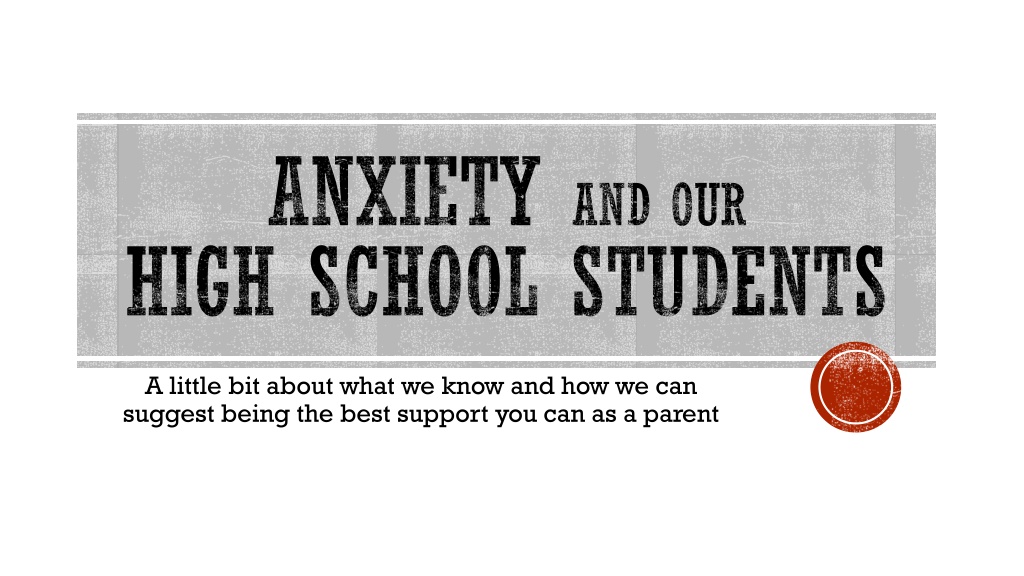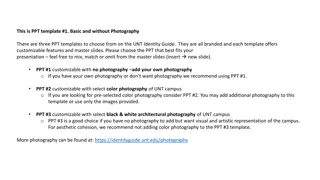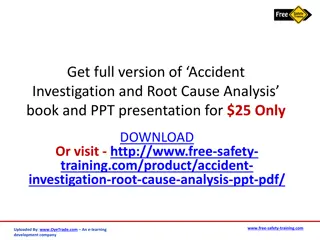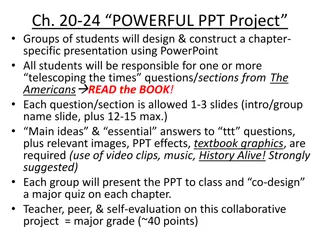
Understanding Anxiety in High School Students
This article sheds light on anxiety in high school students, distinguishing between normal and problem anxiety. It discusses the prevalence of anxiety disorders among school-age children and explores common stressors causing anxiety among students. The content also examines expressions of anxiety in kids and what they are anxious about, offering insights for parents on being supportive.
Download Presentation

Please find below an Image/Link to download the presentation.
The content on the website is provided AS IS for your information and personal use only. It may not be sold, licensed, or shared on other websites without obtaining consent from the author. If you encounter any issues during the download, it is possible that the publisher has removed the file from their server.
You are allowed to download the files provided on this website for personal or commercial use, subject to the condition that they are used lawfully. All files are the property of their respective owners.
The content on the website is provided AS IS for your information and personal use only. It may not be sold, licensed, or shared on other websites without obtaining consent from the author.
E N D
Presentation Transcript
ANXIETY AND OUR HIGH SCHOOL STUDENTS A little bit about what we know and how we can suggest being the best support you can as a parent
A LOOK AT A STRESSFUL SITUATION The German Coast Guard is requested to provide assistance and misses the mark https://www.bing.com/videos/search?q=youtube+german+coast+guard+we+are+sinking&&view=d etail&mid=B9633A32079EE8E0C032B9633A32079EE8E0C032&FORM=VRDGAR
DEFINING WHAT IT IS: Anxiety = the uneasiness, worry, or tension that we experience when we expect a real or perceived threat to our welfare. It is necessary for preparation for and protection from danger. -Wagner, 2005 There is an important difference, however, between normal anxiety and problem anxiety.
THE DIFFERENCES: NORMAL VS. PROBLEM ANXIETY Problem Anxiety ( Works against us ) Normal Anxiety ( We make it work FOR us ) oExcessive oDetrimental oUncontrollable oParalyzing oPervasive oChronic oAge-mismatched Wagner, 2005 Reasonable Productive Manageable Mobilizing Specific Time-limited Age-matched
IT IS COMMONLY ESTIMATED THAT 1 IN 8 SCHOOL-AGE CHILDREN HAVE DIAGNOSABLE, PROBLEM ANXIETY. MOST COMMON MENTAL HEALTH DX. Sometimes this is not recognized as such and other times anxious feelings are unwittingly fueled by our reactions to them and then become problematic.
EXPRESSIONS OF ANXIETY WITH KIDS Their Worry Bucket is always full. If not worried about X at the moment then worried about Y instead.
WHAT ARE STUDENTS ANXIOUS ABOUT? Not Not being able to get into best colleges enough down time Not meeting parents expectations social status TESTS ! Meeting demands of schoolwork Not meeting environment s expectations friendships Class presentations
EXPRESSIONS OF ANXIETY ACROSS TIME Younger childrenoften demonstrate: Outward distress Adolescents often demonstrate: # Internalized worry Crying Freezing Restlessness Irritability/Unreasonableness Nausea/Aches Meltdowns Excessive need for Reassurance # Withdrawal and avoidance # Giving up on things they once enjoyed # Difficulty concentrating # Difficulty making future-oriented decisions #Intolerance for distressed feelings Wagner, 2005
COMMON MISTAKES IN PARENTING RESPONSES TO CHILDREN WHO ARE ANXIOUS In an effort to help, we may actually be unwittingly fueling their anxiety. Wagner, 2013 -acting protective -walking on eggshells -on alert for distress -rushing to rescue -removing all obstacles to ensure success (bulldozer parenting) -hesitating to encourage child to take risks -feeling sad, frustrated, angry, guilty -Wa-Wag
NO ONE CAN RIDE THE BIKE FOR YOU.
ANXIETY TRIAD Thoughts Physical Behaviors Arousal/Feelings
ANXIOUS THOUGHTS WE MIGHT HAVE Overestimation of danger and threat Expectation of worst outcome Sense of uncontrollability Responsibility for negative outcomes Underestimation of coping ability Need for certainty Perfectionism Wagner, 2005
PHYSICAL AROUSAL SYMPTOMS OF ANXIETY Tense, nervous, jittery Butterflies in stomach Nausea, vomiting Heart pounding Palms sweating Breaking out in a rash Shortness of breath On the lookout for danger Wagner, 2005
ANXIOUS BEHAVIORS Checking to make sure things are safe Reassurance-seeking ( Will it be okay? ) Escape leaving the situation Avoidance staying away Wagner, 2005
ANXIETY IS BAD FEELINGS. WE TEND TO AVOID THEM, BUT BAD FEELINGS THEMSELVES ARE HARMLESS. . . AND. . . . . . they actually make us stronger because we overcome them.
SO WHAT IS THERE TO DO? (OVERCOME) Best practices in helping to raise children who are resistant to problem-anxiety (not all anxiety!)
COGNITIVE- BEHAVIORAL THERAPY (CBT) Gold Standard in treating anxiety
ABOUT CBT Scientifically backed up to 80% treatment efficacy in children Goal: To bring anxiety back into normal range Acts on Anxiety Triad if change thinking, change feelings, and change behavior Active, experiential, skill-building approach that parents can assist in coaching their children. Wagner, 2005
CBT TECHNIQUES: REALISTIC THINKING Skill Example of the Skill What makes me think that I will never be able to pass algebra? Finding the evidence (What am I worried about and why?) Judging the accuracy of beliefs (Are my thoughts logical?) Just because I struggled on one test, does that mean that I will fail another? I have managed to work hard and pass other math classes. I wonder if the last test was more difficult or if I have a better understanding of this unit than the last. I could work really hard and do much better than I think I will. Examining alternatives (What else could happen?) It is okay that I am unsure about my math skills. I will work the hardest I can and that will help me to get through this difficult class. Accepting uncertainty (It is okay to feel unsure.) If I don t pass the test, after all, so I retake it or use it as a tool to work with my teacher to learn and prepare for future success. Exploring the worst consequence (So what if it does happen?) Challenging things help me grow and everyone is challenged at something. Just because math is not a strength doesn t mean I will fail at life. Wagner, 2005 Putting things in perspective (What is the big picture here?)
CBT TECHNIQUES: EXPOSURE The tough-love part of CBT To overcome anxiety you must face the fear/anxiety Do not escape or avoid it that only strengthens it Exposure weakens it Anticipatory anxiety is often greater than the anxiety actually felt when exposed to the fear/uncomfortable situation Ride out the feeling of anxiety and it will subside (habituation) You can t get used to the cold water in the pool if you are standing at poolside. You have to jump in! Wagner , 2005
CBT TECHNIQUES: RELAXATION Taking voluntary control over involuntary tension (works well alone for mild anxiety) Examples: Deep breathing Coping statements ( I think I can; I think I can; I think I can. ) Visual imagery Progressive muscle relaxation Grounding strategies and other mindfulness practices Wagner, 2005
COGNITIVE COPING CARDS It is difficult to remember to use the tools we have when anxiety is taking over. What to put on them: Reminder: physical symptoms are just anxiety Reminder: anxiety is not dangerous, won t harm me, and won t last forever Positive self-talk ( I have gotten through this before and I will do it again. I ve got this. ) Reminder: use coping skills ( I can use deep breathing, make a list of what I am grateful for/the protective factors in my life, ask for help, use grounding technique. ) Calming facts ( Bad things usually don t happen. What I am worried about is possible but not probable. ) Coping cards remind us to use the tools we have to boss anxiety back.
OTHER STRATEGIES TO COACH: Feeling thermometer quantifies anxiety 1-10 Rank order then lean into least anxiety provoking scenario Limit digital life (phones and social media have exponentially increased anxiety/decreased face-to-face supportive relationships) Increase social time and leisure activities Increase amount of restorative sleep Engage in gratitude practice Mantra that you believe in and can call on in tough times Positive Psychology (Martin Seligman) what s going well? Model coping with your own real-life experiences
MHS PREVENTION Freshman Seminar (Helping students understand their strength tool box ) Physical Strength Importance of movement to brain, heart health Mental Strength Each day should have an attainable accomplishment (always something to hang your hat on at the end of the day) Emotional Strength The value of exposure to positive emotions to overcome negative ones. (3:1) ratio Social Strength Less Phone, more social contact Gratitude (one thing you are grateful for in a day) Less Have To s and more Want To s Sources of Strength : A researched-based curriculum Upstream approach using strengths and social support to help us through difficult times
RESOURCES YOU MAY FIND HELPFUL Websites, blogs, books, curriculums, apps
10 Common Mistakes Parents Today Make (Me Included) - article https://www.huffingtonpost.com/kari-kubiszyn-kampakis/10-common-mistakes-parents-today- make-me-included_b_4753451.html Letting Teenagers Fail: Why it Matters - blog http://understandingteenagers.com.au/blog/letting-teenagers-fail-why-it-matters/ How Parents Can Help with Coping with Stress https://www.mghclaycenter.org/parenting-concerns/grade-school/stress-awareness-parents- can-help-children-stress/ The Anxiety Wellness Center (Aureen Wagner) video resources https://www.anxietywellness.com Worried No More book/curriculum that much of presentation comes from by Aureen Wagner https://lighthouse-press-inc.myshopify.com/products/worried-no-more-second-edition Mind Shift App free helpful app https://www.anxietybc.com/resources/mindshift-app
Coping Cat Parents -great research-based program http://www.copingcatparents.com/Tips_from_Experts http://www.copingcatparents.com/everyday_stress http://www.copingcatparents.com/Child_Anxiety_Tales - interactive web-based parent training modules to help us better support our children with anxiety. Cost involved. Anxiety BC website excellent interactive hands-on tools for adolescents and parents https://www.anxietybc.com/ Bite Back - General practice for health: positive psychology, program clinically proven to build resilience and improve well-being in adolescents https://www.biteback.org.au/ Test taking article on simple practice to relieve test anxiety http://diverseeducation.com/article/14622/
A BIRD SITTING IN A TREE IS NEVER AFRAID OF THE BRANCH BREAKING BECAUSE HER TRUST IS NOT ON THE BRANCH BUT IN HER OWN WINGS. Thank you.






















